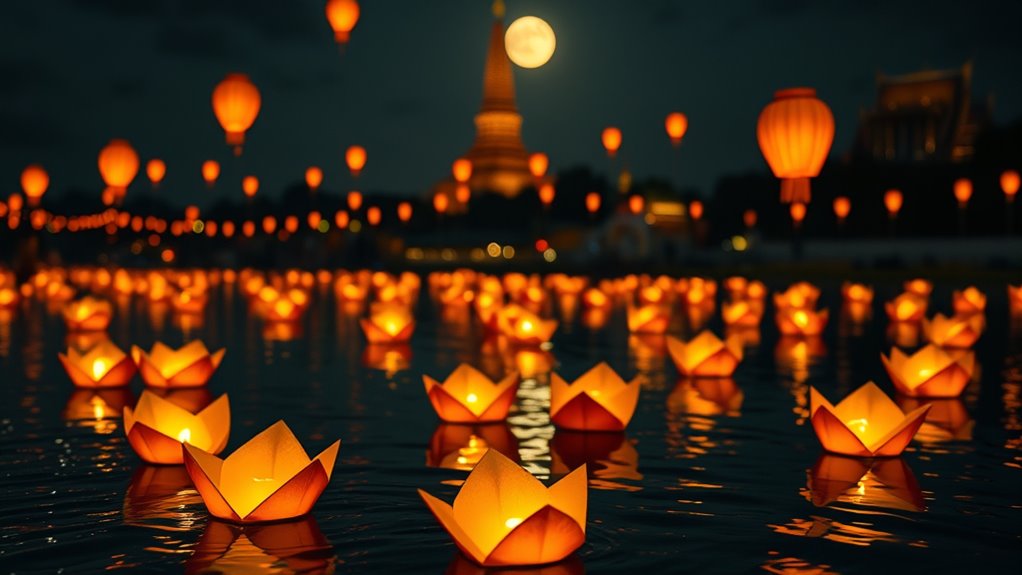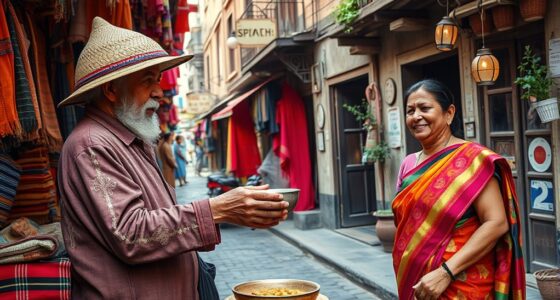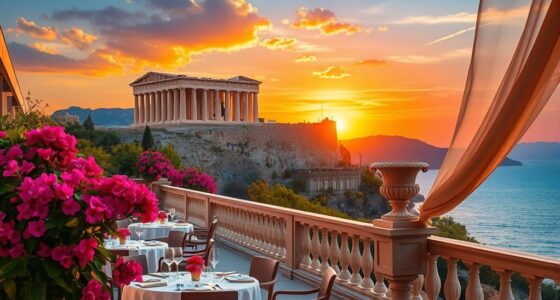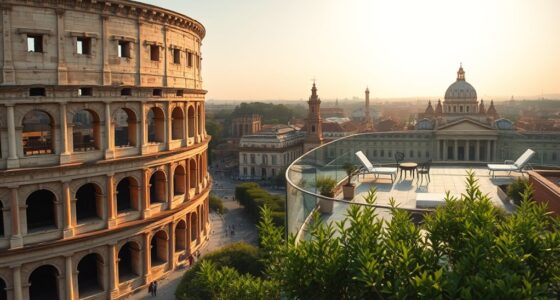Experiencing Loy Krathong in Thailand means floating beautifully decorated baskets and lanterns on water, symbolizing renewal and gratitude. You’ll see vibrant krathongs made from natural materials and water lanterns illuminating the night sky. By participating in these traditional rituals, you’ll connect deeply with local customs, nature, and spirituality. Each float carries wishes for luck and happiness, creating an unforgettable scene. To discover how to make the most of your experience, keep exploring further.
Key Takeaways
- Participate in floating krathongs on rivers or lakes, symbolizing letting go of negativity and making wishes.
- Attend local festivals with candle lighting and floral decorations to immerse yourself in traditional Loy Krathong practices.
- Experience regional customs like sky lantern releases during Yi Peng in northern Thailand for a unique water and sky celebration.
- Choose eco-friendly krathongs made from biodegradable materials to enjoy the festival sustainably.
- Visit popular celebration spots early to secure ideal views of floating lights, lantern releases, and vibrant cultural activities.
The Origins and Evolution of Loy Krathong
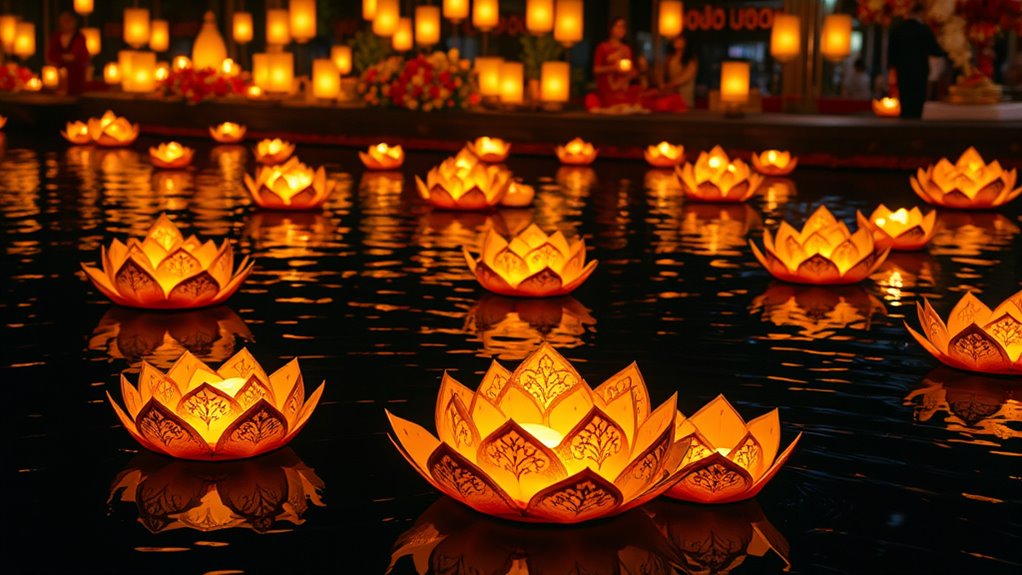
Loy Krathong has a rich history that dates back over 700 years during Thailand’s Sukhothai period, making it one of the country’s oldest festivals. Its origins are rooted in water symbolism, honoring water as a essential element for life and sustenance in Thai culture. The festival’s roots include influences from Hindu rituals, especially those venerating water deities like Ganga, which emphasize purification and renewal. Legend credits Nang Noppamas with creating the first krathong, though some details are literary rather than historical. Over time, Loy Krathong evolved from a royal court event to a widespread celebration, incorporating practices like floating decorated krathongs on water to express gratitude and seek blessings. Its festival origins reflect a blend of cultural, religious, and spiritual traditions centered around water’s significance. Additionally, understanding the figurative language used in describing the festival’s symbolism can deepen appreciation for its cultural richness.
Symbolism and Cultural Significance of the Festival
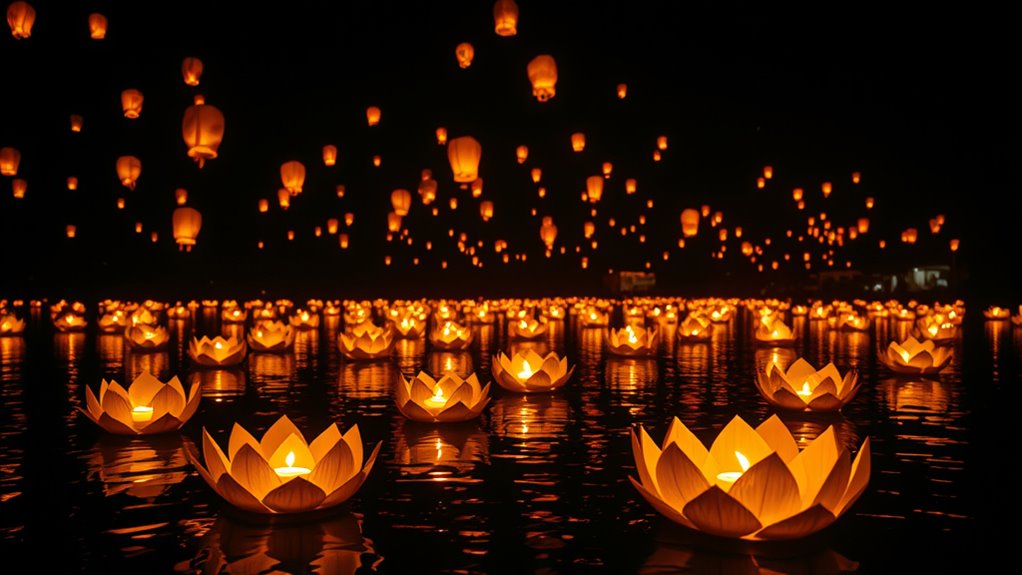
The festival’s vibrant rituals are rich with symbolism that goes beyond the simple act of floating krathongs. Water symbolism plays a crucial role, as you honor Phra Mae Khongkha, the Water Goddess, expressing gratitude and seeking forgiveness for pollution caused during the year. Cultural rituals like releasing krathongs symbolize letting go of anger, grudges, and past misfortunes, preparing you for renewal. The floating baskets carry wishes for happiness and good fortune, while the candlelight honors the Buddha, representing enlightenment and purity. Loy Krathong also reflects Thailand’s spiritual blend of Hindu and Buddhist beliefs, emphasizing respect for nature and life’s interconnectedness. Originates from the Sukhothai Kingdom, over 800 years ago. Through these cultural rituals, you participate in a time-honored tradition of spiritual cleansing, renewal, and communal harmony rooted deeply in Thai culture.
Crafting the Perfect Krathong: Design and Materials
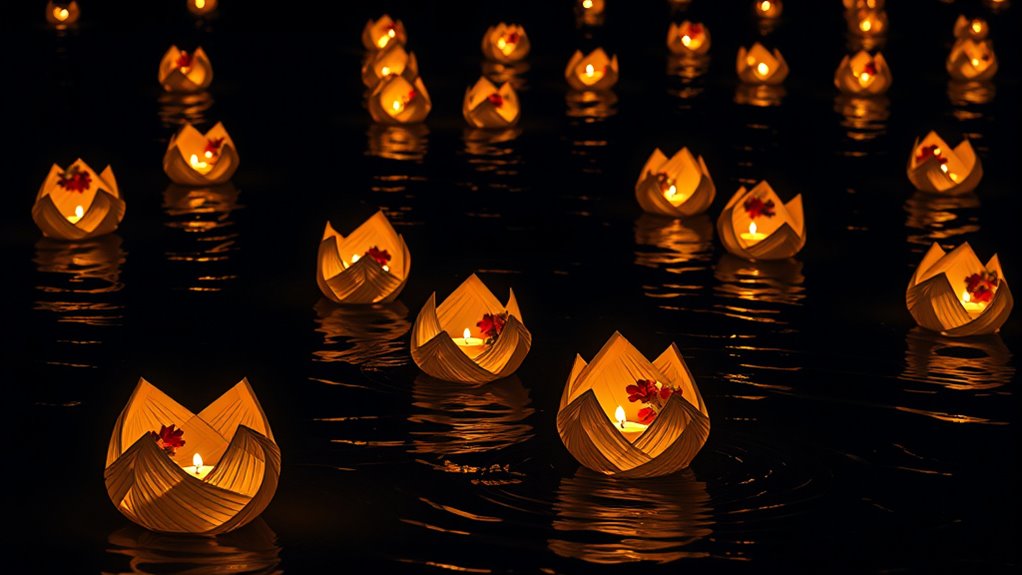
Ever wondered how to craft the perfect krathong that both honors tradition and cares for the environment? Your krathong decoration begins with a biodegradable base, often a slice of banana tree trunk or spider lily plant, sourced sustainably to guarantee eco-friendliness. You can also use bread, which disintegrates naturally and feeds fish, or steer clear of Styrofoam and plastic, which are now banned for pollution reasons. To enhance your design, fold fresh banana leaves into intricate patterns and arrange vibrant flowers like marigolds and orchids, emphasizing natural beauty and sustainability. Secure these with pins, toothpicks, or twine for stability. Carefully selecting eco-conscious materials and focusing on artistic yet practical design helps create a beautiful, environmentally responsible krathong. Using eco-friendly materials not only honors tradition but also helps protect water resources for future celebrations. Incorporating environmentally sustainable practices can further reduce pollution and promote conservation during Loy Krathong.
Traditional Activities and Modern Celebrations

During Loy Krathong, you’ll see both traditional rituals like lighting candles and making offerings, as well as modern events such as lantern releases and fireworks. These celebrations blend ancient customs with contemporary festivities, creating a vibrant atmosphere. Whether participating in spiritual practices or enjoying lively performances, the festival offers a diverse experience for everyone. The festival date varies each year based on the full moon cycle, adding a unique timing element to each year’s celebrations. The rustic decor and natural materials used in traditional decorations further enhance the authentic ambiance of the festivities.
Traditional Rituals and Offerings
As the full moon rises in the 12th lunar month, communities gather at rivers and ponds to perform traditional rituals that honor the water deity. You’ll see locals carefully craft their Krathongs, decorating banana trunks with banana leaves and vibrant flowers to honor the Water Goddess. Incense sticks and small candles are inserted, symbolizing spiritual offerings and illumination. These offerings express gratitude for water and seek forgiveness for pollution. Participants often perform prayers and rites before launching their Krathongs, believing the floating basket will carry away bad luck and negativity. The ritual blends spiritual reverence with cultural traditions, emphasizing respect for nature and community harmony. These ceremonies reinforce the deep connection between Thai spirituality, environmental respect, and cultural identity. Establishing healthy boundaries during these festivities helps participants maintain respect for individual needs and communal harmony.
Contemporary Festivities and Events
Loy Krathong’s vibrant celebrations now blend age-old traditions with modern festivities, drawing crowds from all over the world. Lantern festivals and water processions take center stage, creating stunning visual displays. In Chiang Mai, the Yee Peng festival features thousands of sky lanterns, lighting up the night sky alongside floating water lanterns, a dual spectacle unique to Northern Thailand. In cities like Bangkok, water processions along the Chao Phraya River showcase colorful floating parades, cultural performances, and fireworks, blending traditional and contemporary elements. Markets flourish with vendors selling handcrafted krathongs, lanterns, and souvenirs. Modern organizations guarantee safety during lantern releases and promote environmental care. These events attract tourists and locals alike, celebrating Thailand’s rich heritage through dazzling light displays, lively performances, and communal water activities. Incorporating sustainable practices ensures these beautiful traditions can be enjoyed by future generations.
The Timing of Loy Krathong Within the Lunar Calendar
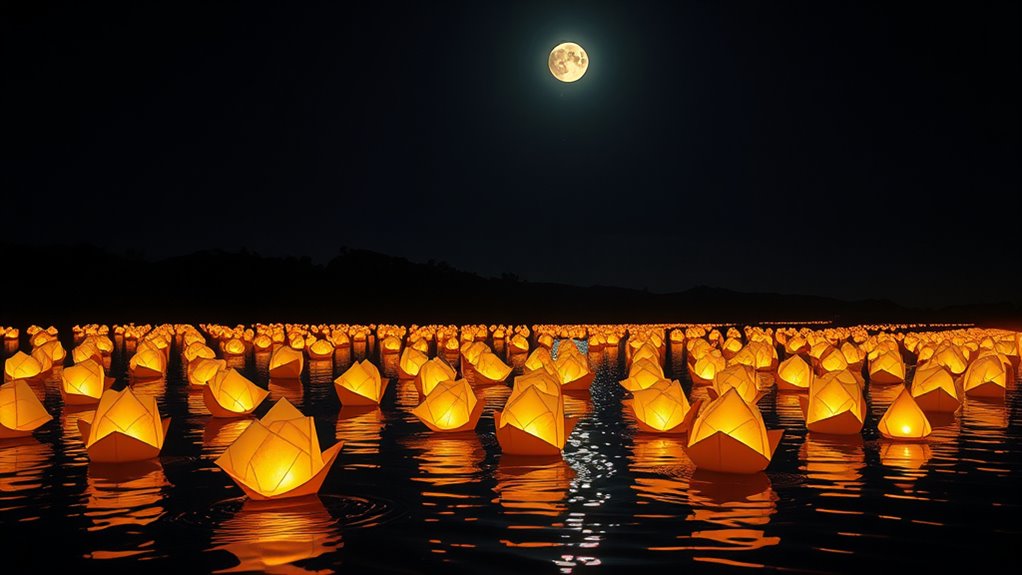
You’ll notice that Loy Krathong is always held on the full moon night of the 12th lunar month, which varies each year within the Gregorian calendar. This timing is linked to the lunar calendar’s cycles, causing the festival date to shift, sometimes by weeks. Regional differences and lunar observations influence the exact date, making each year’s celebration unique. The lunar calendar’s influence on festivals like Loy Krathong highlights the importance of traditional timekeeping methods in cultural celebrations.
Lunar Month Significance
The festival of Loy Krathong takes place on the evening of the 12th lunar month in the traditional Thai calendar, with its date shifting each year based on lunar phases. This timing aligns closely with the full moon, marking the month’s end and symbolizing renewal. Because the lunar calendar follows moon phases, the date varies annually, usually falling between early and late November in the Gregorian calendar. This calendar alignment connects the festival to natural cycles, emphasizing the importance of water and agricultural seasons. The timing reflects a deep cultural significance, honoring water spirits and encouraging spiritual cleansing. The variable date guarantees Loy Krathong remains rooted in lunar astronomy, maintaining its harmony with celestial rhythms and seasonal transitions. Additionally, the lunar calendar’s connection to agricultural cycles underscores the festival’s role in celebrating harvests and ensuring prosperity.
Full Moon Timing
Loy Krathong is celebrated precisely on the evening of the full moon in the 12th lunar month according to the traditional Thai calendar. The festival’s date aligns with the lunar phase, specifically the full moon, which marks a significant seasonal timing in Thailand. This timing coincides with the end of the rainy season and the onset of cooler months, making it ideal for water-based celebrations. Because the lunar calendar varies each year, the festival’s date shifts within November, depending on the full moon cycle. The lunar phase’s influence guarantees the celebration remains rooted in traditional timing, regardless of the Gregorian calendar. This seasonal timing, tied to lunar mechanics, emphasizes the festival’s spiritual and cultural significance, symbolizing completion and renewal. Lunar phases play a crucial role in determining the exact date of Loy Krathong each year, underscoring the importance of celestial cycles in cultural festivities.
Regional Variations
While the full moon generally marks the official date for Loy Krathong across Thailand, regional differences influence the exact timing within the lunar calendar. In the Lanna region, especially Chiang Mai, the festival aligns with the Lanna lunar calendar, often coinciding with the Yi Peng Festival, which lasts three days around the full moon. Lantern releases are carefully scheduled to match auspicious lunar phases, sometimes just after or on the night of the full moon, guided by regional tides and moon visibility. In Sukhothai and other areas, celebrations extend over several days, with local customs affecting the precise timing. These variations ensure the festival’s spiritual and cultural significance remains connected to regional lunar traditions and natural lunar influences. Additionally, the increasing popularity of sustainable eco-friendly practices has influenced some communities to adopt environmentally conscious lanterns and celebrations.
Rituals of Gratitude and Spiritual Cleansing
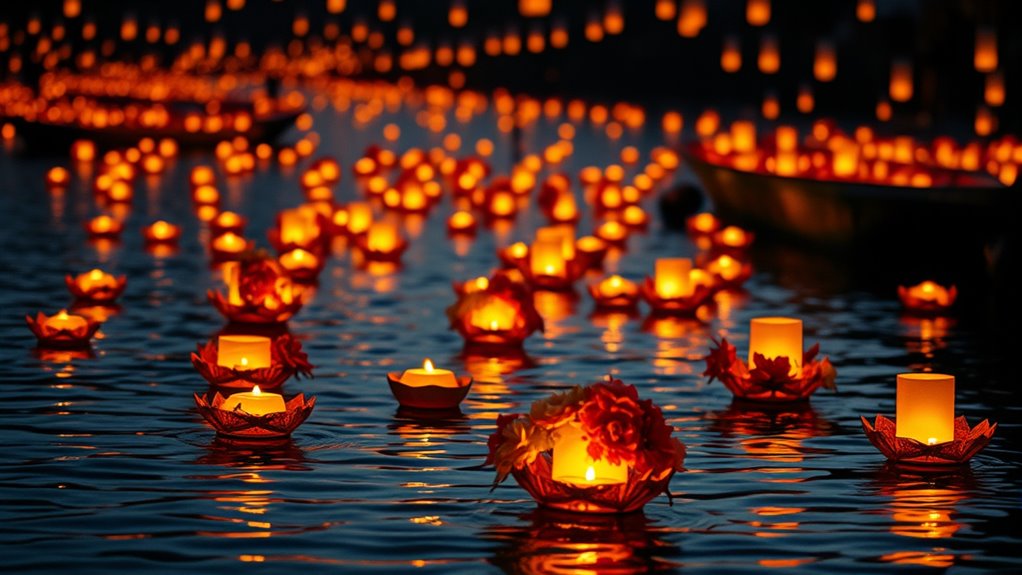
During Loy Krathong, people actively participate in rituals that express gratitude to water deities and promote spiritual cleansing. Water symbolism plays a central role, as floating krathongs honors Mae Khongkha, the water goddess, acknowledging water’s essential role in life and agriculture. The ritual significance lies in offering thanks and seeking blessings for prosperity, health, and peace. Lighting candles and incense on krathongs symbolize purity, light, and reverence. These acts also serve as a symbolic release of negativity, sins, and misfortunes, fostering emotional and spiritual renewal. Crafting and floating krathongs become communal acts, strengthening social bonds and cultural values. By gathering at water’s edge to pray and make wishes, participants deepen their connection to water’s symbolic importance and engage in meaningful rituals of gratitude and cleansing. Additionally, the act of floating krathongs embodies the Water symbolism that is integral to the festival’s spiritual significance.
Environmental Considerations and Eco-Friendly Practices
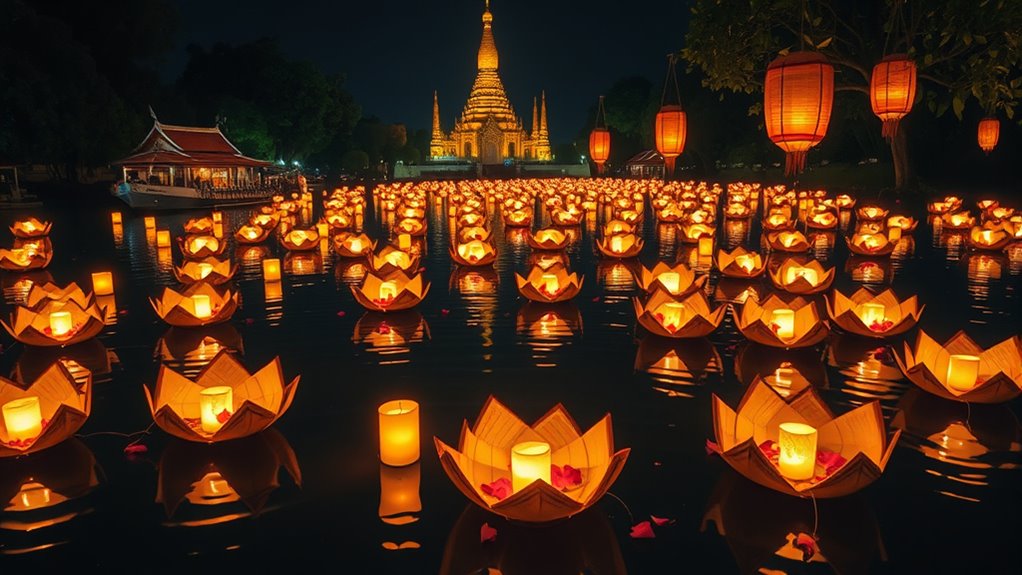
As the vibrant celebrations of Loy Krathong unfold, environmental considerations have become a crucial focus to guarantee the festival’s sustainability. To reduce water pollution, many promote using biodegradable waste, with over 96% of krathongs collected last year being biodegradable. These are often transformed into fertilizer at waste treatment facilities, helping limit non-biodegradable debris. However, polystyrene krathongs still make up a small percentage, threatening waterways with long-lasting pollution. To minimize ecological impact, authorities encourage hosting celebrations in controlled, designated areas, making waste management easier and preventing clogging in natural waterways. Community cleanup efforts help remove organic and non-biodegradable debris, reducing environmental harm. Promoting eco-friendly alternatives, like natural materials and reusable floats, further supports sustainable practices and protects aquatic ecosystems during Loy Krathong. Developing mindset & confidence around environmental responsibility can motivate individuals and communities to adopt sustainable practices and contribute to the festival’s ongoing preservation.
Regional Variations and Unique Local Customs
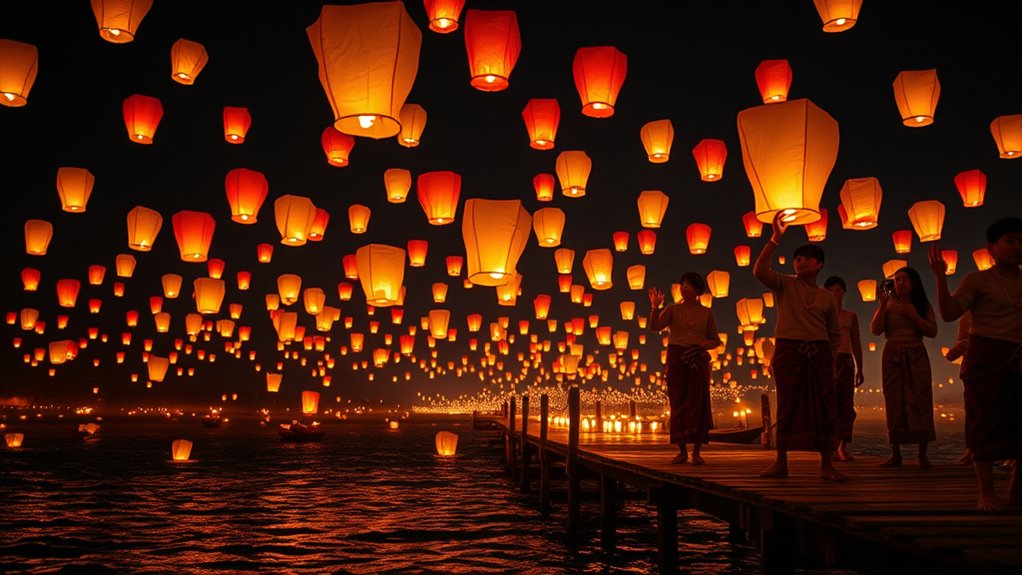
As you explore Loy Krathong across Thailand, you’ll notice that each region celebrates on different dates and with distinct customs. In Northern Thailand, the Yi Peng Festival features lantern releases, while the northeastern areas highlight boat parades and light displays. These unique practices reflect local beliefs and traditions, making each celebration truly special. Additionally, some regions incorporate regional variations in traditional practices that showcase the diverse ways Loy Krathong is observed throughout the country.
Local Festival Dates
Loy Krathong is celebrated on the full moon night of the 12th lunar month, but its exact date varies across regions due to the shifting lunar calendar. You’ll notice differences in timing, especially between northern and central Thailand.
- Chiang Mai often extends celebrations over multiple days, with elaborate Loy Krathong attire and festival food traditions lasting longer.
- Bangkok’s Water Lantern Festival usually takes place around mid-November, focusing on river-based activities.
- Rural communities may celebrate on dates close to the full moon but sometimes shift to align with local customs or harvest cycles.
- The festival’s food offerings often include regional specialties, showcasing local culinary traditions and American diner classics, adding to the festive atmosphere.
These variations influence not just the timing but also the festivities’ mood, attire, and food. Regional differences add richness to the Loy Krathong experience, making each celebration unique.
Unique Ritual Practices
Regional variations give Loy Krathong a rich tapestry of unique customs that reflect Thailand’s diverse cultural landscape. In different regions, the krathong symbolism and water spirits are celebrated through distinctive practices. In Sukhothai, torchlight processions and Miss Noppamas contests highlight historical roots, while Chiang Mai’s combination with Yi Peng creates a mesmerizing sky lantern and water krathong festival. Materials vary: banana sheaths in Sakon Nakhon, coconut shells in Tak, and banana leaves in central Thailand, each honoring local resources. Additionally, the incorporation of local crafts emphasizes regional artistry and cultural identity.
Experiencing Loy Krathong: Tips for Visitors
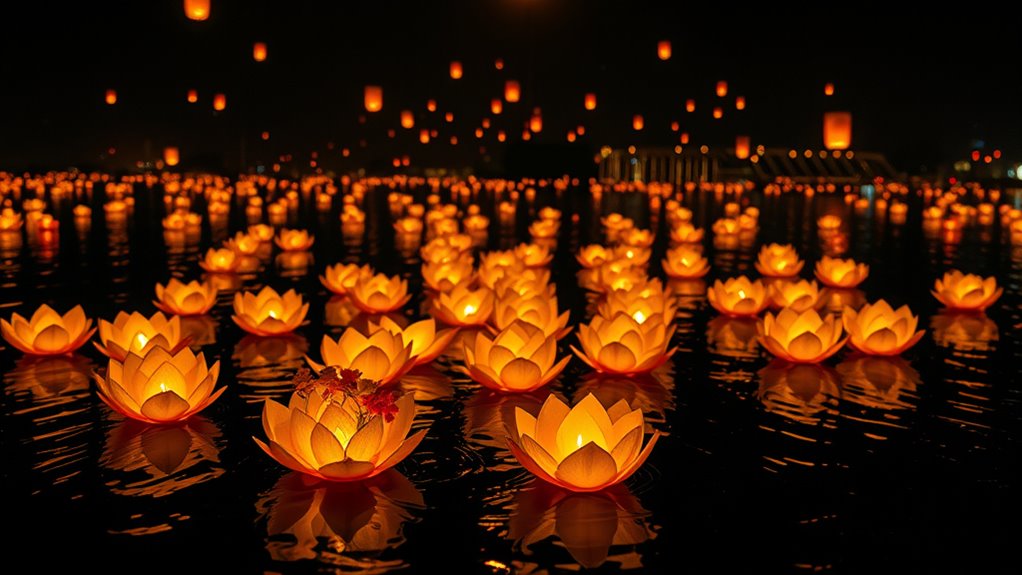
To make the most of your Loy Krathong experience, plan ahead by choosing the right locations and activities that match your interests. Consider where you’ll see the most vibrant celebrations, whether at temples, riverside spots, or festivals with lantern releases. Here are some tips:
- Arrive early to secure prime viewing spots for floating krathongs and lantern releases.
- Dress respectfully, opting for traditional or modest festival costumes to honor the cultural significance.
- Participate in lantern craftsmanship workshops or craft your own krathong to create a personalized experience.
- Be mindful of AI in Business innovations that are transforming event management and enhancing cultural celebrations through technology.
The Festival’s Role in Connecting People, Nature, and Spirit

The festival plays a pivotal role in strengthening the bond between people, nature, and spirit by creating shared experiences rooted in cultural and spiritual traditions. Water symbolism is central, honoring *Phra Mae Khongkha* and expressing gratitude for water’s life-giving power. Floating krathongs symbolize asking for forgiveness for polluting water resources, fostering spiritual respect for nature. Participants often wear festival costumes that reflect local customs, strengthening cultural identity and communal spirit. The act of releasing krathongs and lanterns visually connects everyone to water and natural cycles, symbolizing renewal and hope. These rituals promote environmental mindfulness and reinforce the importance of water preservation. Loy Krathong’s collective participation unites communities, nurturing a sense of harmony, forgiveness, and spiritual renewal rooted in shared tradition.
Frequently Asked Questions
How Do Different Regions in Thailand Celebrate Loy Krathong?
You’ll notice regional variations in Loy Krathong celebrations across Thailand. In the north, you’ll see colorful parades, traditional dance, and floating lanterns, reflecting local culture. Central regions host grand events with fireworks and cultural shows, emphasizing history. In the south, coastal areas focus on beach ceremonies, blending maritime traditions. Throughout, culinary traditions play a role, with regional foods enhancing festivities. Each area uniquely celebrates water, culture, and community.
What Are the Traditional Prayers or Chants During the Festival?
During Loy Krathong, you’ll hear traditional blessings and folk melodies that deepen your experience. People silently offer prayers for good fortune, prosperity, and forgiveness, often directed to water deities or spirits. Folk chants and the Loy Krathong song serve as poetic prayers, expressing gratitude and hopes for renewal. These prayers and melodies create a spiritual, communal atmosphere, blending Buddhist mantras with local traditions to honor water and seek blessings for the future.
How Has Modern Technology Influenced Loy Krathong Celebrations?
Modern technology has markedly shaped Loy Krathong celebrations through digital innovation and reducing environmental impact. You can now participate in virtual krathong events, viewing stunning projection mappings on landmarks without waste. LED and laser lighting designs enhance the festival’s atmosphere while minimizing pollution. Eco-friendly materials and biodegradable options, supported by technology, lessen ecological harm. Overall, tech transforms the festival into a more sustainable, immersive experience that celebrates Thai culture creatively and responsibly.
Are There Specific Colors or Decorations Symbolizing Particular Meanings?
You might think festival decorations are just eye-catching, but they’re packed with symbolic colors that tell stories. White and yellow flowers show purity and spirituality, red signals love and luck, blue stands for hope and peace, while green represents renewal. These symbolic colors shape your krathong’s decorations, turning simple river offerings into meaningful expressions of wishes, gratitude, and new beginnings during Loy Krathong.
How Can Visitors Participate Respectfully in Local Loy Krathong Customs?
To participate respectfully in Loy Krathong customs, you should follow cultural etiquette by dressing modestly, removing shoes before entering sacred spaces, and engaging politely with locals. Use biodegradable materials for your krathong and dispose of waste responsibly to minimize environmental impact. Light candles and incense as part of the tradition, and approach the festival with reverence, understanding its spiritual significance beyond mere celebration. Your respectful participation honors the culture and preserves the environment.
Conclusion
As you drift through the glow of Loy Krathong, remember each flickering lantern is a whisper of tradition, a prayer sent skyward. Embrace the festival’s magic, connecting with its deep roots and vibrant celebrations. Let the water carry your hopes, your gratitude, your renewal—like ripples that spread far beyond the river’s edge. In this luminous dance of light and water, you find more than a festival; you find a heartbeat of Thailand itself.
